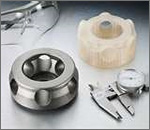Introduction: Prototype casting is a rapid prototyping process used to replicate die casting that can be used to test of the fit, form and function of the original parts. Prototype casting and the rubber plaster mold enables in casting prototypes using aluminum, zinc, brass, bronze and magnesium. Prototypes casting helps in meeting casting project deadlines quickly.
Prototype castings are made to improve the existing products, develop a new product, etc.
 Process:
Process: In prototype metal casting, an SLA master model is replicated on a silicone rubber and used as the reusable master pattern. Using the pattern a mold is created using the air-set sand process or plaster mold process. Molten metal is poured into the pattern and cooled. When the metal solidifies, it is removed by break opening the pattern. With expert engineering and designing high tolerance prototype parts can be produced. Prototypes can be made either by the plaster, rapid investment casting or air-set sand process.
Plaster Cast Prototypes: This is the best method to produce metal prototypes that will be die cast production parts. Plaster slurry, usually made of gypsum or calcium sulfate mixed with talc, sand, asbestos, etc. is sprayed on the SLA pattern halves. The mold is then extracted from the pattern, fixed with gates and sprues and used for the prototype casting purpose. Aluminum and zinc alloy with better surface finish, can be plaster cast.
Sand Casting: The process is similar to plaster mold prototype casting, but more economical. The products has a rough surface finish. Iron, aluminum and zinc alloys can be cast in this manner.
Applications: Prototype castings are required by a wide rang of industries like aerospace, aircraft, communication, military, etc. Intricate designs with aesthetic beauty can be prototype cast using metals like beryllium, copper, aluminum, etc.
Advantages of Prototype Casting:
- Metal prototypes parts help in changing the design of the component as per requirement of the customers
- Prototype castings reduce time to market and helps in evaluating potential markets
- Prototype parts assist in U.L. approval and in house testing.
- Prototype castings help to evaluate aesthetic application where appearance is critical.
- Prototype castings can be used for sales presentations or marketing shows.
- Quickly evaluate metal part design
- Prototypes can be made of almost any metal material
- Allow testing of the part in the actual production materials
In prototype metal mold casting, an SLA master model is replicated into silicone rubber and used as a reusable master pattern for a single-use plaster mold. This method is limited to low-melt alloys such as Aluminum and Zinc. The process of plaster mold casting can be summarized as such:
SLA Master Pattern (positive) → RTV mold (negative) → RTV mold (positive) →
Plaster mold (negative) → Final casting (positive)
A plaster, usually gypsum or calcium sulfate, is mixed with talc, sand, asbestos, sodium silicate, and water to form a slurry. This slurry is sprayed on the polished surfaces of the pattern halves. The slurry sets in less than 15 minutes to form the mold. The mold halves are extracted carefully from the pattern and then dried in an oven.
The mold halves are carefully assembled, along with the cores. Then, the molten metal is poured in the molds. After the metals cools down, the plaster is broken and the cores are washed out.
Usage:
Materials with low melting temperature, such as aluminum and zinc, can be cast using this process. This process is used to make quick prototype parts as well as low volume production parts.
Limitations:
Size: Parts cast are usually small to medium size, ranging in weight from 30g (1 oz) to 7 kg (15 lb).
Finishing: The surface finish is 1.25 µm to 3 µm (50 µin to 125 µin) RMS.
Contact us to buy or for more information on prototype casting, prototype metal casting, prototype metal mold casting and prototype metal castings.


